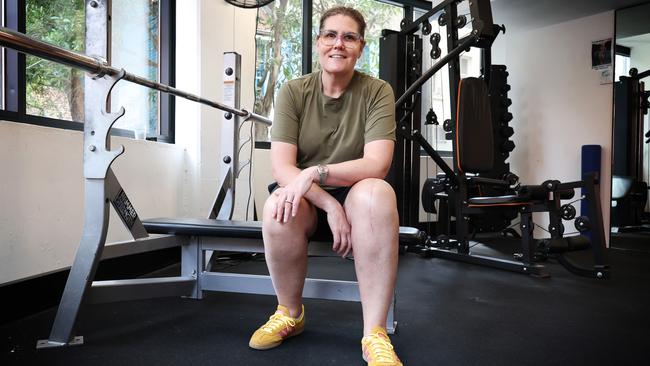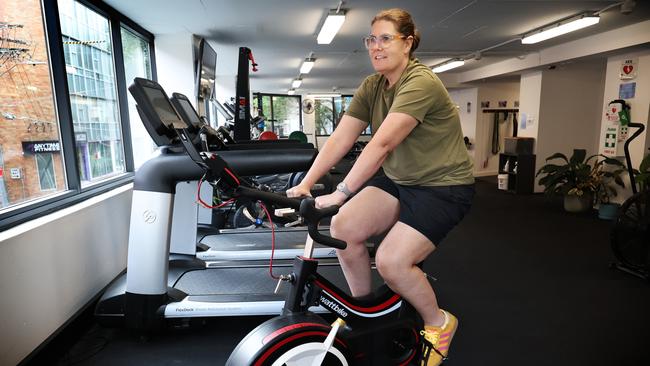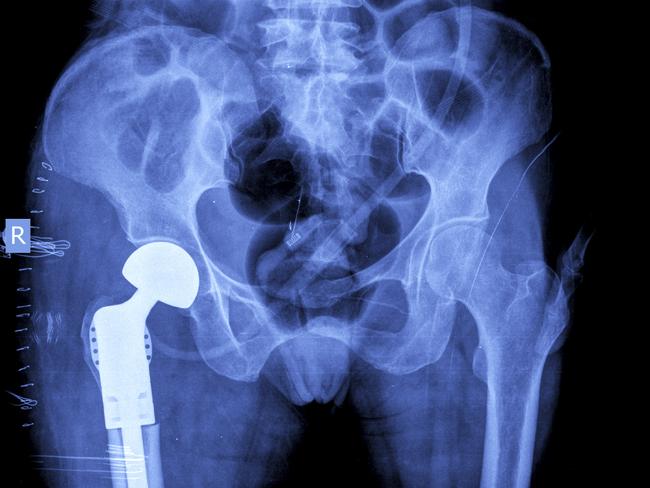We could be paying too much for knee and hip replacements
As more baby boomers have their joints replaced and the population struggles with obesity, we need to ask whether our care is too expensive and too reliant on private insurance.

Late last year I spent four nights in acute care in a private hospital, six nights in a private rehabilitation hospital and five weeks as an outpatient at that hospital. Four years ago I spent 16 nights in those hospitals and about three weeks as an outpatient. Nothing too serious – just total hip replacements, the sort of routine surgery that baby boomers like me are having in spades, although low blood pressure led to that longer stay the first time around.
Nothing too serious and nothing too special. Joint replacement surgery is the new black in medicine as an ageing – and heavier – population discovers that it doesn’t have to limp into old age with painful osteoarthritis.
I am one of more than 135,000 people in Australia who got new hips or knees in 2024 and the numbers are growing at the rate of 8 to 10 per cent a year. It is life-changing surgery for most people, who generally are walking with a frame within hours of emerging from theatre and are back to their normal activities within weeks.
So, nirvana for most patients – although knee replacements are more painful and recovery longer – and a nice living for orthopaedic surgeons who can charge private patients several thousand dollars for what is routine, albeit significant, surgery.
Leave aside the cost of private surgery, the post-operative care and rehabilitation available for private healthcare patients are bargains.

I paid a total of $1000 for all those weeks as an inpatient and outpatient in 2020 and 2024. Two surgeons were happy to refer me to rehab units when I requested this – in part, it must be said, because I had no assistance at home and also had stairs to negotiate.
But here’s the rub: my fund probably forked out $35,000 to $40,000 for that hospital-based care for what is increasingly regarded as day surgery in Europe.
Little wonder that, as University of Sydney rheumatologist David Hunter says, health funds are “screaming” about the high cost of joint replacements in Australia. Post-operative care for hip and knee surgery costs more than $1bn a year, he says, but “I don’t think anybody’s paying any attention because both surgeons and patients just expect the private health funds to pay”.
Yet there’s a great deal of evidence, Hunter says, that “your outcome in terms of pain, function, recovery is no different if you go straight home from the acute surgery than if you go off and have rehab in a private hospital”.
Ben Harris, director of policy and research at the funds’ peak body, Private Healthcare Australia, isn’t screaming but he’s certainly worried about the rising rate of replacements and hospital-based care that is often the default position in Australia.
Advocating for a new model is certainly about costs – he estimates the funds could save up to 10 per cent if we cut average hospital stays in half and offered options of follow-up physiotherapy outside hospitals – but he says this can be achieved without any loss of quality and safety.
“It doesn’t work for everyone but the evidence shows that the shorter the stay in hospital, the better the result,” Harris says.
The rationale is that if you are rehabilitating with abstract exercises in a rehab unit, it’s not always as good as being at home and finding your way around real-live tasks and challenges, And even if it’s not better, if the outcomes are equal, as research suggests, why do Australians on average spend double the time in acute beds than patients in most other countries – about 4.3 days for knees and 3.9 for hips – followed often by several days in a rehab unit?
Ilana Ackerman of Monash University says our private health system is structured to encourage hospital-based care because the cost of admission is largely being covered by health funds.
Ackerman, deputy director of the musculoskeletal health unit at the university’s school of public health and preventive medicine, says although the short-stay model is being adopted more and more overseas, “we’re just not there yet in Australia”.
Private health insurance has helped create a “persistent” high reliance on inpatient rehab with rates of inpatient rehab three times higher for patients having joint replacements at private hospitals compared with public hospitals.
Says Ackerman: “If you were to have your joint replacement in a public hospital in Australia, it would be much less common for you to go to inpatient rehab unless you really needed it for clinical reasons. But in the private system there’s much more access and we see much higher rates of inpatient rehab.
“The evidence is just not there to support the use of inpatient rehab for people who have had uncomplicated surgery, but we’ve still got a really high use of inpatient rehab in Australia. It’s likely driven by a number of factors including surgeon and patient preferences.”
She says many people see the positive experience of friends and family members and regard inpatient rehab as a way of getting value from their private health insurance, which they may have held for many years. Patients commonly ask their surgeon to refer them and, given the cost is often covered by health funds, the surgeon may be happy to do so.
“There’s the availability of beds in the private system compared to relatively few inpatient rehabilitation beds in the public system, and it’s being funded by private health insurance,” Ackerman says. “Unless the funding structure changes, the situation is unlikely to change.”
(Ackerman’s unit has received a research grant from the HCF Research Foundation, the charitable arm of the HCF insurance fund, for its short-stay research program.)
Harris says the funds want doctors to be better informed on the science: “We need to encourage them to look at the research and consider options. Cost is a factor but it’s about costs and benefits.”
He says the average cost for a hip replacement – including 3.9 days in hospital, theatre and nursing charges, the implant and the amount covered by Medicare – is $24,069. For knees, with an average stay of 4.3 days, the cost is $22,269. Almost half of that is for the acute hospital stay. That’s before any days in a rehab hospital, which as “a rule of thumb” is $700 a day, he says.

The surgeons’ body, the Australian Orthopaedic Association, acknowledges the increased interest in shorter hospital stays and day surgery but its president, Scott Fletcher, says the quality of care should always be the priority and decisions must not be about cost-cutting.
“While early discharge can be beneficial for some, it is not suitable for all patients,” he says. “AOA supports the development of efficient, high-value care models that enable earlier discharge and home rehabilitation where appropriate, but we do not endorse blanket discharge policies driven primarily by financial incentives.”
The other significant factor adding to costs are the numbers opting for surgery.
Australia has one of the highest rates of joint replacements in the world. About three million Australians are living with osteoarthritis and the numbers are growing in an ageing population.
Obesity is also a problem, with excess weight seen as a leading risk factor for the condition. Only about 10 per cent of people with osteoarthritis end up having surgery and the rest manage with core treatments, such as activity and maintaining a healthy weight, use of anti-inflammatories, braces and modifications to footwear. But Hunter says we should encourage more people to adopt the non-surgical options before they opt for surgery.
“We did an analysis a few years ago of people getting THRs (total hip replacements) in NSW, and about 70 per cent of them had seen a surgeon and were put on a list to have their surgery done without any appropriate care before they had (the surgery),” he says.
He says there are a couple of reasons for this.
“We do what our doctor tells us,” he says. “So if you go along and see your GP, and your GP says, ‘Look, you’ve got osteoarthritis, there’s not a lot that I can do for you’, and they refer you to a surgeon, your anticipation, your expectation when you see that surgeon, is that you’re going to get an operation.
“The surgeon then says things to you like, ‘Your X-ray doesn’t look great; inevitably, you’re going to require a joint replacement’, then your belief about your ability to continue to manage this disease without an operation (declines).”
In short, an orthopaedic surgeon in general advises you of your surgical options, period. You may decide not to proceed but you will generally have to go somewhere else for advice in managing your osteoarthritis.
Hunter says the other structural problem is that while surgery attracts a Medicare rebate, other preventive care, such as help to lose weight, is not well supported by the healthcare system.
The annual cost of healthcare for osteoarthritis is about $5bn a year, Hunter says.
“About half of that is spent on joint replacements, and about a quarter of it is spent on recovery from joint replacements. So, in excess of $1bn per year is spent on recovery and rehabilitation from surgery (even though) you would get the same outcome as an outpatient.”
Louise Hunt, a senior staff member at global tech company Canva, spent three nights as a private patient in an acute hospital, then 10 days at the private Wolper Jewish Hospital in Woollahra in Sydney. The 44-year-old says she would have been “petrified” to return home a day or two after her total knee replacement.

She paid an excess of $750 for the hospital nights and several weeks of outpatient care twice a week at Wolper. As an inpatient there she says she appreciated the chance to rest and the emphasis on good nutrition as much as the two hours of daily physiotherapy. Hunt went back to her job as global workplace experience lead at Canva three weeks after her operation and now, three months after the surgery, is doing well. She estimates she is only about a third of the way through her recovery and is still taking anti-inflammatory medicine and icing her knee daily, but she can ride a bike through the city and is pain free.
She had worried the surgery would be “one of the most horrific things I’ve ever experienced” but it turned out to be “a 6½, or a seven” on a scale of 10. She needs her other knee replaced in the next year or so but says of her recent operation: “I wish I’d done it years ago because the pain is gone. I have discomfort when it swells, but I have no pain. And, you know, having been on pain relief for about 10 years, it’s the best thing I’ve ever done.”
While Hunt appreciated the two hours of physio and hydrotherapy each day at Wolper, Ackerman argues it’s an expensive way to deliver those services compared with home visits or patients attending a local physiotherapist or hydrotherapy pool.
In contrast to the long hospital rehab experienced by Hunt and me, Kerry Macfarlane, who like me is 74, spent just two nights in an acute bed before she went home and used private providers for her rehab. Her surgeon checked her home situation (she has a husband and no stairs in her Perth house) and she said she was happy to go home, armed with good pain relief medication and detailed written material about post-operative care. She paid an excess of $500 for her two nights in hospital and her out-of-pocket expenses were $384 for her physiotherapy and hydrotherapy sessions, which totalled $544 for five physio appointments and hospital pool entry fees.
The push to move patients out of hospital quickly follows vastly improved surgical and rehabilitation processes in the past 25 years. In the 1990s, patients were often kept in bed and were relatively immobile in the initial days before they were allowed to get up and walk with a physiotherapist. Now, in some settings, says Ackerman, patients are out of bed within two hours of surgery.
“We’ve been moving to getting people up and out of bed much earlier because we know it prevents respiratory complications and minimises the risk of having blood clots,” she says. “We also don’t want patients losing muscle strength in other areas of the body.
“There’s less blood loss than there used to be, smaller wounds and fewer drips and drains. The pain management is better and we try to reduce the medications that have an impact on people’s blood pressure and nausea so they feel more comfortable when they get up and start walking.”
While the design of the hip prosthesis – the ball and socket – has not changed much over the decades, newer materials and fixation methods have increased the life span of the prosthesis and dramatically reduced the need for “revisions” – that is, a re-do of the replacement.

“When I first started working in orthopaedic rehabilitation, patients were being told around 15 years was what you got with a joint replacement,” says Ackerman. “But these days only about 11 per cent of hip replacements and 8 per cent of knee replacements have been revised by the 20-year mark. People’s new joints can last well beyond 20 to 25 years.”
The advent of 3-D manufacturing could lead to more customised implants tailored to the individual, although Hunter suggests this is “more a selling point” and there is no evidence to support the idea that a bespoke joint makes much difference.
Hunter is more focused on the need to address increased weight, which he says accounts for about 40 per cent of the “population attributable risk” in knee replacements. Every extra kilogram a person carries translates to 4kg of load across their knees, he says.
“We know, based upon research that we’ve done, that if we can get a person to lose 10 per cent of their body weight, which obviously sounds like a lot, their symptoms will improve by 50 per cent,” he says.
The next big issue in this area is likely to be the pressure from overweight patients to take the popular GLP-1 receptor agonists to lose weight before surgery. Under the Pharmaceutical Benefits Scheme, doctors cannot prescribe these drugs for osteoarthritis, so they can be very expensive for some patients.
The AOA’s Fletcher says surgeons recognise that these drugs medications can be helpful for pre-operative weight management.
“However, cost and availability remain barriers for many patients, and clinical considerations such as temporary discontinuation before surgery must be addressed,” he says.
The costs for the private health funds do not end with hospital care; they also cover the cost of implants, which can range from about $4500 to $7700 for a hip – and that’s 30 to 100 per cent more expensive than in comparable countries.
The prices of prothesis are set by the federal government and Harris says: “Reducing the costs of medical devices to internationally competitive levels will help reduce private health insurance premiums for Australian consumers.”





To join the conversation, please log in. Don't have an account? Register
Join the conversation, you are commenting as Logout